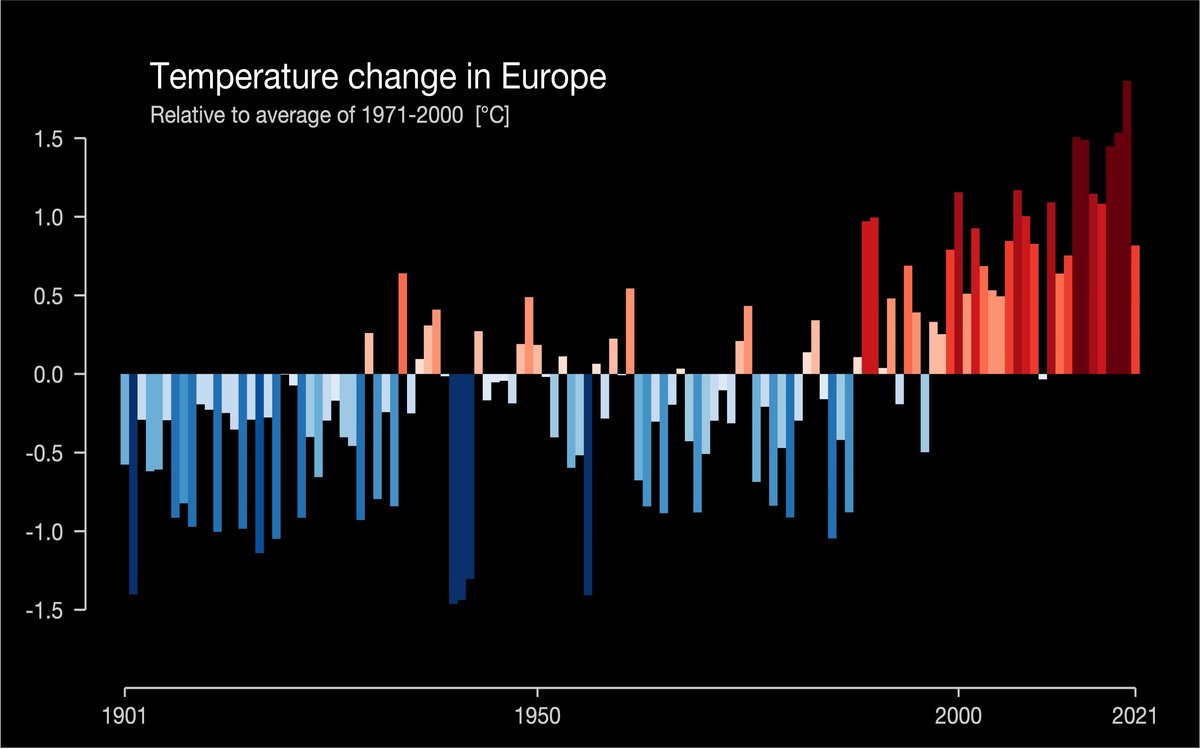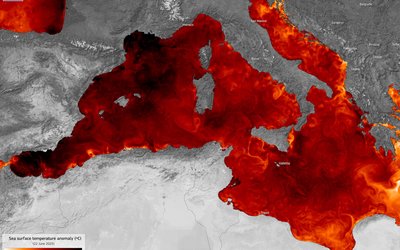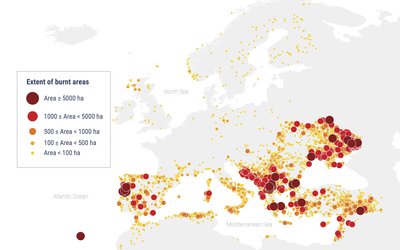
Source photo: https://showyourstripes.info/c/europe/all
Mainline
The latest projections of future temperatures over Europe show that warming will be largest both in the northernmost latitudes (Norwegian Sea, Scandinavia, and Russia) and in the southern part of Mediterranean Europe (mainly in Spain and Turkey). The lowest warming is projected to occur in the British Isles and surrounding areas.
In northern Europe, in particular the coldest winters will be less cold in the future; warming will be relatively high for minimum winter temperatures. In southern Europe, on the other hand, the hottest summers will be much hotter; warming will be relatively high for maximum summer temperatures.
These projections are based on both a moderate and a high-end scenario of climate change. The moderate scenario leads to a global mean temperature increase of about 2.5°C when compared to the pre-industrial era. According to experts, this is a realistic scenario. The high-end scenario leads to a global mean temperature increase of about 5°C when compared to the pre-industrial era. This scenario assumes that current emissions of greenhouse gasses will continue unabated this century; experts stress that this is not realistic, it is a worst case. In these projections, three 20-year time periods were considered: the reference period 1995 - 2014, 2046 - 2065 (medium-range future), and 2081 - 2100 (long-range future).
Moderate scenario of climate change
Average warming
By the middle of this century, warming in northern and southern Europe can reach 1–2.5°C under the moderate scenario of climate change. By the end of the century, warming in these parts of Europe can reach 3–4°C. Warming does not seem to surpass 1°C in the British Isles and surrounding areas even for the long-term future.
Hot days
The number of hot days, with a mean temperature > 30°C, is projected to increase in the southernmost regions of Spain and Turkey. Compared with the reference period 1995–2014, this increase is around 15–30 days per year in the mid-term future and 35–45 days per year for the long-term future. The rest of Europe does not show an increase in the number of hot days.
Very hot days
The number of very hot days, with a maximum temperature > 40°C, will probably not change much in Europe until the end of the century, except for some localized areas in Spain and southern Turkey.
Tropical nights
Changes in the number of tropical nights are relevant for human health, since warm nights do not allow a complete human body recovery from the diurnal heat stress. The number of tropical nights will increase in the Mediterranean area by 20–40 nights per year mid-century, reaching 40–60 nights per year by the end of the century in the south-central part of Portugal and Spain, and in Italy, Greece, and some areas of southern Turkey.
Frost days
The number of frost days, with a minimum temperature < 0°C, is projected to decrease in practically all of Europe already by mid-century. The decrease is strongest in northern Europe. By the end of this century, this decrease reaches 40–60 days per year in Scandinavia and even more than 100 days per year in the Norwegian Sea and Iceland, under a moderate scenario of climate change.
High-end scenario of climate change
Average warming
Under the high-end scenario of climate change, warming in northern and southern Europe by the middle of this century is like the one projected under the moderate scenario towards the end of the century: 3–4°C. Towards the end of the century, warming in northern and southern Europe can reach 5–6°C.
Hot days
The number of hot days is projected to increase in especially southern Europe. This increase is around 35–45 days per year in the mid-term future. By the end of the century, this increase can reach up to 70–80 days per year for Portugal, Spain, Turkey, and some localized areas in Greece, and up to 40–60 days per year in other parts of southern Europe.
Very hot days
The number of very hot days will probably strongly increase by the end of the century in southern Europe: up to 40–50 days per year in the southern parts of Portugal, Spain, and Turkey, and up to 5–10 days per year in the central-southern parts of Europe.
Tropical nights
For the number of tropical nights, the mid-century projection under the high-end scenario is like the end-of-century projection under the moderate scenario. A high increase in the number of tropical nights is projected for the end of the century in all of Europe (except for Scandinavia and the British Isles). This increase is in the order of 50–80 nights per year and can reach 80–100 nights per year in Portugal and Spain.
Frost days
Under the high-end scenario of climate change, the number of frost days will reduce by more than 100 days per year in Scandinavia and north-eastern Russia by the end of the century.
Source: Carvalho et al., 2021. Climatic Change 167: 10.








